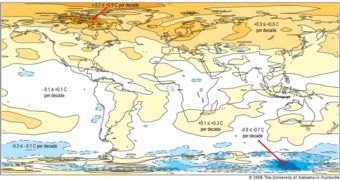According to new research, temperatures rose globally by an average of half of a degree Fahrenheit (0.3 Celsius) over the last 3 decades, due to man-caused global warming. Most heating occurred in the regions around the North Pole, in Northern Canada, Greenland and Scandinavia, where temperatures spiked by as much as 4.6 degrees F (2.5 degrees C), prompting massive ice meltdowns and the concern that the Pole could lose all its ice in the summer before 2050.
"If you look at the 30-year graph of month-to-month temperature anomalies, the most obvious feature is the series of warmer than normal months that followed the major El Nino Pacific Ocean warming event of 1997-1998," says University of Alabama researcher Dr. John Christy, who is also a professor of atmospheric science and a director of the Earth System Science Center (ESSC).
"Right now we are coming out of one La Nina Pacific Ocean cooling event and we might be heading into another. It should be interesting over the next several years to see whether the post La Nina climate 're-sets' to the cooler seasonal norms we saw before 1997 or the warmer levels seen since then," he adds.
The scientist also notes that several regions of the Antarctic actually cooled down by as much as 0.7 – 0.9 degrees Celsius, especially in the Eastern part of the area. The cooling makes up in part for the heating at the North Pole, but still falls short of covering for it. Looking at the graph could make you believe that the planet compensates for its own warming, but data shows that ocean acidity has also changed, due to pollution, and that this fact has a very negative influence on the climate.
As proof, scientists say that even the Antarctic saw massive ice sheet melts, in its Western part, and that the underground lakes that fuel the movement of the glaciers are accelerating right now.
The changes in temperature were only visible after 1997-1998 because only global averages were recorded before that time and, on average, the planet did not heat up. However, localized temperature rises prompted disturbances in the climate, which translated into more severe storms, droughts and floods in sensible areas throughout the globe.
The current heating pattern, revealed by Christy, has not yet been accounted for in many of the models that try to predict climate change globally. This happens mostly because all other models view the planet as going through uniform changes, whereas it actually looks more like a thermometer.

 14 DAY TRIAL //
14 DAY TRIAL //